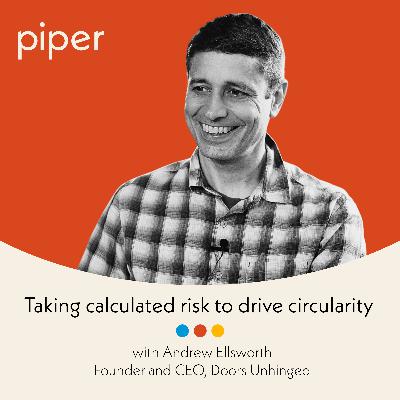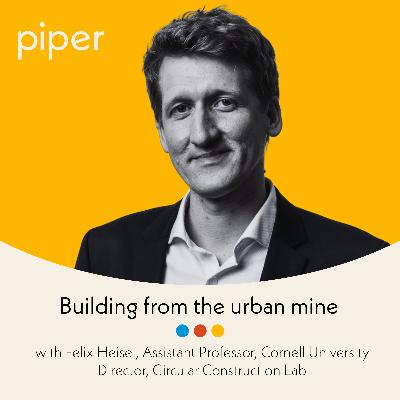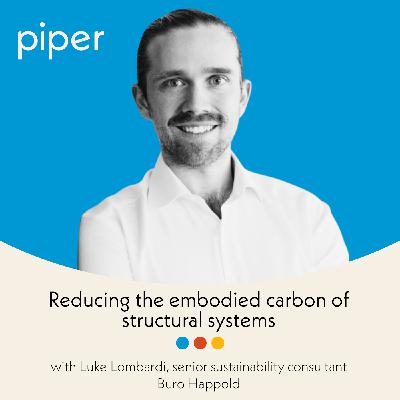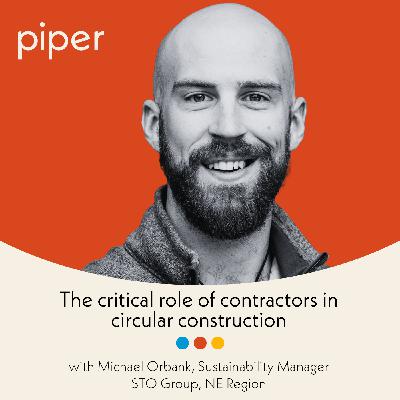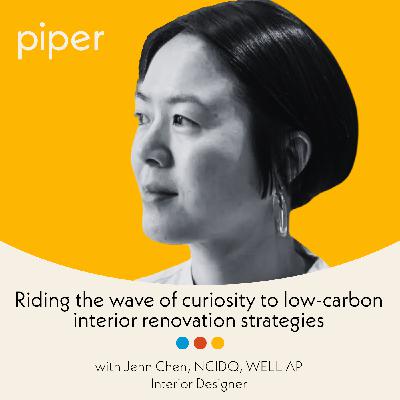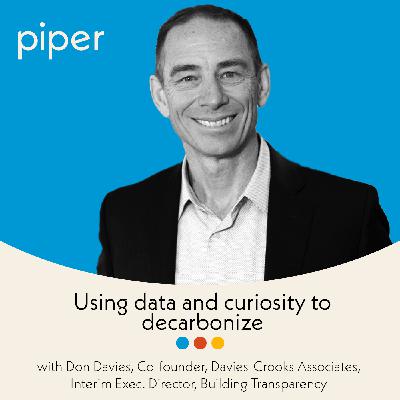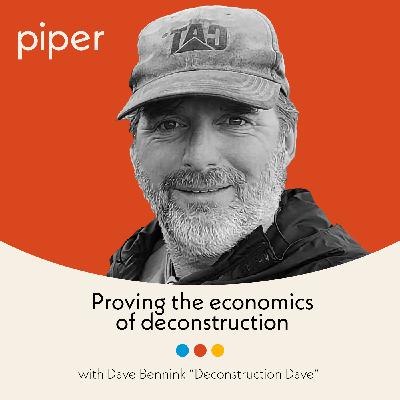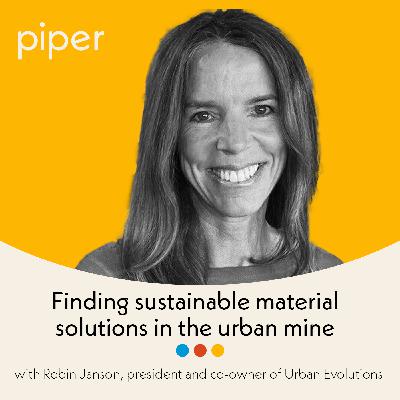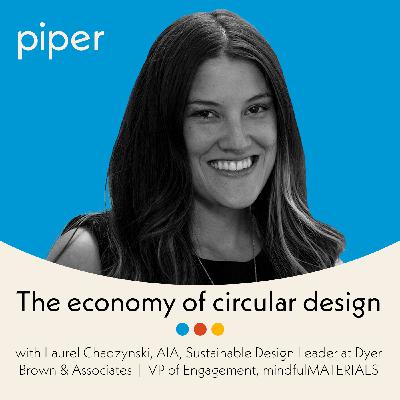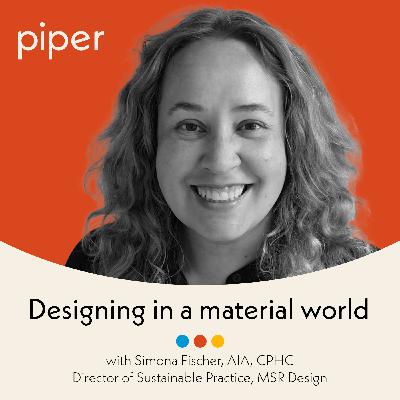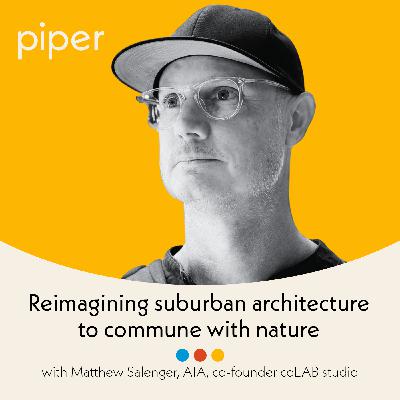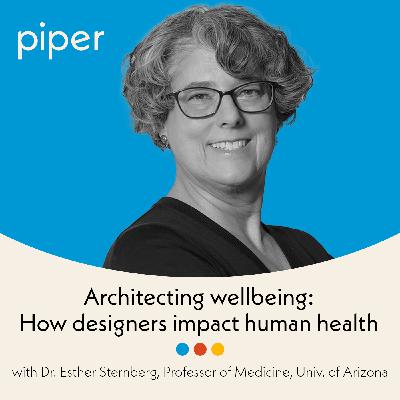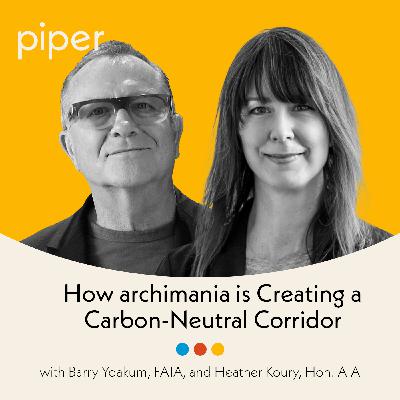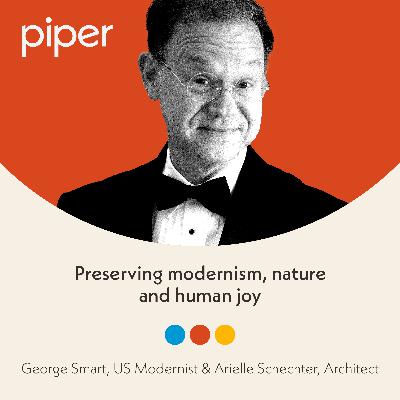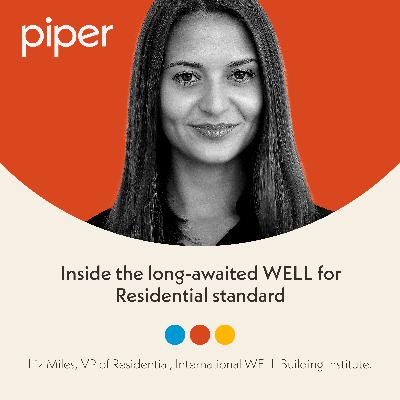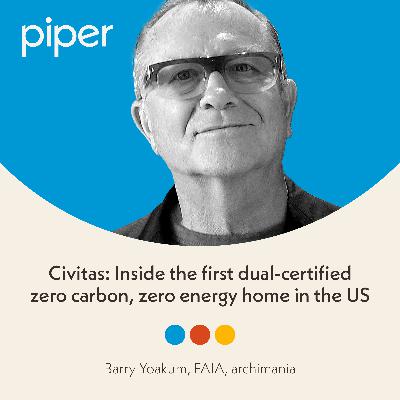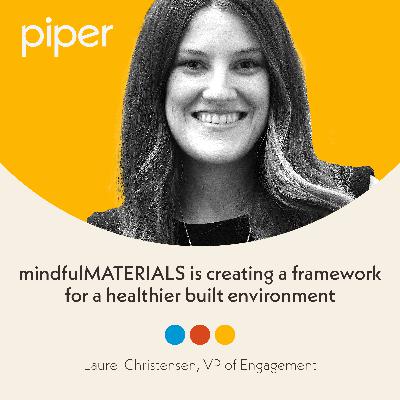Discover piper: decoding healthy & regenerative design
piper: decoding healthy & regenerative design

piper: decoding healthy & regenerative design
Author: Piper Republic
Subscribed: 0Played: 0Subscribe
Share
© 2024
Description
Piper explores the diverse stories of the designers, architects, builders, brands and wellness experts working to make the built environment healthier and more sustainable for people and planet. Each episode aims to decode the complexities of healthy and regenerative design to make it more accessible to designers of all backgrounds.
21 Episodes
Reverse
Andrew Ellsworth seems to have an incessant appetite for risk. But dig a little deeper and you see that that appetite is fueled by a profound desire to drive the positive changes that will support environmental health. And he’s using the built environment as the entry point to create that change. In addition to launching Doors Unhinged, the first US company to reclaim and resell commercial door systems, Andrew also co-founded the All For Reuse initiative to strengthen the demand for reclaimed materials. He also recently collaborated with Hennepin County in Minnesota to develop Building Circularity MN, and, as part of that program, is leading a training to help entrepreneurs build viable material reuse businesses. And when he’s not doing all of that, he still finds time to take to the stage, speaking and advocating for circularity and reuse, which is where I found him, between his multiple speaking sessions at the Build Reuse conference. In this episode, Andrew shares how Doors Unhinged came to be, the challenges of launching a business in a sector that wasn’t designed for circularity, and where he sees the biggest opportunity for entrepreneurs in the circular economy.
It’s difficult to capture all that the multi-hyphenate Felix Heisel has achieved and created in the world of circular architecture in the past 15 years. Since graduating from architecture school in Germany, circular construction has been a central focus of his career. He’s authored numerous books and papers on the topic, created and now directs the Circular Construction Lab at Cornell University, and has led countless circular construction exhibitions and research projects around the world, including one of his most current, called AR3-Lumber, an AI-driven application that will visually grade reclaimed lumber. At this year's Build Reuse conference, Felix shared some of the findings from their studies and what he sees as important next steps to bring circular architecture more mainstream.
In the structural engineering of buildings, concrete and steel are among the most widely used materials. Concrete is actually the most abundant manufactured material on earth. But for all of the tremendous qualities these commonly used structural materials provide, they come with high environmental costs in the form of embodied carbon. And many structural engineers are starting to take note...and do something about it. One such engineer is Luke Lombardi, a senior sustainability consultant at the engineering consultancy firm, Buro Happold. And at this year’s Build Reuse conference, Luke spoke about the major impact structural engineers can have on the path to net zero. In this episode, he shares some of those insights and talks about how natural building materials fit into the picture.
Michael Orbank began his career as an environmental field technician, sampling soil and water to better understand the implications of petroleum contamination. But through conversations with subcontractors while on various job sites, Michael began to see an alternative pathway that could position him to make a bigger impact in the world of sustainability. So, he went back to school, earned a master’s in civil engineering and initially entered the field as a project manager at a construction firm. That role didn’t fully satisfy his deep-seated interest in sustainability, so he began seeking out like-minded groups in the Boston area. He soon found himself in a session led by the Carbon Leadership Forum about embodied carbon in buildings. And it was that session that turned the kaleidoscope for Michael. Fast forward to present day, and Michael is serving as a sustainability manager at STO Building Group and advocating for the contractor’s role in escalating reuse in the building industry. At this year’s Build Reuse conference, Michael shared how he’s leveraging this position to further circularity and why contractors are essential partners in achieving circular construction.
The seemingly benign act of curiosity actually has a very bold undercurrent. It has the power to conquer fear, challenge the status quo, propel innovation, and cultivate solutions. Curiosity is what drove Albert Einstein to revolutionize modern physics, and Walt Disney to produce the first feature-length animated film, which forever changed the industry. And curiosity is what has led interior designer Jenn Chen, a former partner at LMN Architects, deep into the world of circularity and understanding the carbon impact of cyclical interior renovations. Through her exploration of new design possibilities that could serve people and planet, Jenn co-created the firm’s Path to Zero Carbon series, developed foundational research in interior design’s role in lowering embodied carbon, and has inspired countless others in the industry to get curious about carbon and circularity. In this episode, Jenn shares some of the lessons learned in trying to integrate circular design into interior projects, how they're thinking about carbon in cyclical interior renovations, and how designers can start to incorporate circularity in their own practices.
Over the course of his 35-year career as a structural engineer and as the past-president of the Seattle-based MKA Structural Engineers, Don Davies has guided the construction of numerous high-rise buildings around the world. But nearly 15 years ago, his focus started to shift after realizing how important structural engineers were to lowering the carbon impact of the built environment, yet they often weren’t included in the conversation. So, Don got curious. And that curiosity, in relative short order, led him to a tribe of like-minded, intrepid individuals who would go on to co-create several organizations and carbon-calculating tools that have forever changed the industry. In this episode, Don shares how the Carbon Leadership Forum, Building Transparency, EC3 and Tally LCA came to be, how they're testing low-carbon materials, and why those in the AEC community should stay curious about carbon.
In the world of deconstruction and circularity, nearly all roads lead back to a handful of industry vanguards. One of whom is Dave Bennink, more commonly known as Deconstruction Dave. Dave has been working to shepherd deconstruction and reuse into the mainstream for the better part of three decades. He brought a reuse innovation center to Bellingham, Washington and is now developing one in New York City. He founded the Building Deconstruction Institute, has led countless deconstruction efforts in cities across the country, and is routinely recruited by economic development organizations to help embed circular principles into local economies. But what drew him to such a physically, emotionally and mentally demanding mission? It was the demolition of his high school and a fortuitous college internship. In this episode, Dave discusses some of the challenges that often stand in the way of deconstruction and material reuse, why demand and timing are key to progressing circularity, and the important role architects, designers and contractors play in driving the mission forward.
It’s estimated that more than 12 million tons of wood are landfilled every year in the US. And this figure doesn’t even take into account the 46 million metric tons of urban lumber that is either landfilled, chipped or burned. In both scenarios, this is wood that still has tremendous economic and environmental value. And often, it’s wood that is rich with history and story. Luckily, there are some intrepid entrepreneurs working to extend the life of this valuable wood by rescuing and processing it, and getting it into the hands of the design-build community. One such entrepreneur is Robin Janson, co-founder of Urban Evolutions, a Wisconsin-based supplier of reclaimed and salvaged wood materials. In this episode, Robin discusses the valuable materials that can be found in the urban mine and how designers can unlock the richness and story that’s often embedded in these salvaged materials.
In the race to reduce the carbon impact of the built environment, and address planetary health and human health, circularity has become a key strategy. But, until more recently, circularity was almost like that one missing Lego piece needed to complete the build. And, as it turns out, that piece was actually sitting right in front of you the whole time…you just didn’t recognize it. Still, even with the prospect of this piece getting you closer to completion, it’s not always as simple as clicking it into place. And that was a primary topic of discussion at this year’s Living Future Conference. For all of its benefits, circularity is not without its challenges. And now, more designers, architects, builders, contractors and manufacturers are exploring and sharing ways to make reuse and circularity more approachable. In this episode, Laurel Chadzynski, AIA, Sustainable Design Leader at Dyer Brown & Associates, and VP of Engagement at mindfulMATERIALS, shares some of the challenges when it comes to creating a truly circular design economy and some ways designers can overcome them.
Take a moment to look around your current environment. Have you ever noticed just how many materials went into the makeup of your immediate surroundings? Materials are everywhere and in everything we come into contact with. As such, they have a massive impact on us and the planet. And there’s a level of complexity in understanding that impact that drew architect Simona Fischer to study them. Today, Simona is the director of sustainable practice at MSR Design based in Minneapolis. And with the knowledge she’s gained over the past 10+ years, she helps educate other designers on how to specify healthier materials and consider reuse as often as possible. In this episode, Simona shares how designers can unearth the health and carbon impact of a material, what tools to use, how to work creatively with salvaged materials, and some of the natural materials she's most excited about currently.
Is it possible to feel like you are genuinely rooted in nature while living in the middle of suburbia? That was the hypothesis architects Matthew and Maria Salenger of coLAB studio set out to test––and they used their 1950s Cedar Street suburban tract home as the test ground. In fact, they embarked on a study of sorts. A study that would span several years and evolve into something much larger than either likely imagined. As they began to rethink the way one could live in suburbia, they unearthed learnings in passive and biophilic design, planet-positive design, modularity and flexibility, and even building with reuse in mind. In this episode, discover what resulted from that multi-year study and how this dwelling, despite being in the middle of a bustling city, feels like an escape to a secluded desert garden.
Dr. Esther Sternberg may not have predicted she would author several books on the built environment’s impact on human health. After all, until 2012, she was working as a senior scientist at the National Institutes of Health (NIH) studying the brain-immune connection. But a chance encounter in 2000 with the then-research director for the US General Services Administration (GSA) would forever change the trajectory of her research work––and it started with one question, “Can we measure the impact of a workplace on employees’ health, happiness and productivity?” It’s a question she answers in her latest book, “Well at Work,” where she details the significant impact the built environment has on human health and longevity. Today, Dr. Sternberg serves as Professor of Medicine in the University of Arizona College of Medicine and as the Research Director of the Andrew Weil Center for Integrative Medicine. She’s also an advisor for the International WELL Building Institute. And it’s through this work and her various roles that she advocates for design professionals to view themselves as health professionals and true partners in the health of the nation. And this is exactly what we discuss in this podcast episode.
Have you ever met one of those people who seems like they’ve already lived a thousand lives in just a matter of decades? Well, Dr. Gautam Gulati (or Dr. G as he prefers) is one of the humans…or rather super humans. He’s earned multiple degrees, from medical to business to design, launched several successful ventures, and speaks around the world...and that's the short list. And the golden thread through each of these endeavors? Changing people’s lives. Of course, Dr. G. also doesn’t shy away from challenges. So when his dad developed a rapidly progressive form of Alzheimer’s and wasn’t getting the support he needed from the traditional healthcare route, he became his full-time caregiver. He moved him into his home then began investigating how the built environment could help or hinder his father’s health, longevity, and safety. After implementing some of these design strategies, they were astounded by the outcomes. Not only did the redesign help reduce agitation and improve happiness, it even cut his father’s medications from 12 to 3. These findings then led Dr. G. to create The Well Home, and now he’s made it his mission to help others change their lives by adapting their environments. In this episode, Dr. G. shares the design strategies they implemented to make a marked difference in his father’s health, and provides tips for creating a well home.
663 S. Cooper may be home to archimania, an architecture firm in Memphis, TN, but that’s just one detail of this unassuming (yet inviting) building on S. Cooper St. What started as the remodel of a pair of midcentury buildings and a tenacious goal of achieving zero carbon, zero energy, blossomed into something much bigger: the making of a connected, carbon-neutral corridor. See how this team of archimaniacs proved the model for achieving zero carbon, zero energy on a budget, and how they’re working to inspire community, connection and carbon neutrality along a three-mile stretch of Cooper St. in midtown Memphis.
Build shelter. Not too big. Mostly plants. Those seven simple words––though borrowed and modified from famed author Michael Pollan in more recent years––embody the ideology that has guided the Bay-area architecture firm Arkin Tilt for nearly three decades. Led by David Arkin and Anni Tilt, they decided early on to hang their hats on ecological design –– mindfully adapting designs to be harmonious with the surrounding ecology and working with bio-based, alternative construction systems like straw bale and rammed earth. And this was well before sustainable design had really caught on in the mainstream. So, what drew them to this relatively unpaved path? David believes it was just something innate in him since childhood. In this episode, David Arkin shares what led them to create Arkin Tilt, some of the interesting materials they are working and some resources other designers can use to start incorporating bio-based and reused materials into their own projects.
Welcome to Vali Mews, a four-home urban development in the heart of Phoenix that was designed as somewhat of an experiment. Several years ago, the duo behind this ambitious project, Austin Trautman and Lucas Johnson, set out to see if they could create the “everything bagel” of good building. Not only did they aim to use materials and building practices that were mindful of human health, embodied carbon and embodied injustice, they simultaneously wanted to address the “missing middle” housing dilemma and create environments that evoked human joy. Were they successful? Take a listen and discover for yourself.
Modernist architecture may be among the more divisive, debated and controversial architectural styles throughout history. But love it or hate it, few can contest its contributions to fundamentally shifting the way humans engage with the built environment. Modernist architects believed in designing spaces that blurred the lines between indoors and outdoors, tapped into primal instincts and desires and eased the stresses of modern life––in a sense, providing architectural therapy. And George Smart, the founder and CEO of US Modernist, a nonprofit organization, is on a mission to promote and preserve modernist architecture and the stories behind it. In this episode, modernist architect Arielle Schechter shares how she connects her designs to nature and uses modernist principles to evoke a sense of optimism and joy.
Most homes are not built with human health in mind. In fact, many are actually contributing to negative health outcomes and overall poor health in occupants young and old. But what does a “healthy” home look like? What features should be incorporated and what should be avoided? This is what the International WELL Building Institute (IWBI) set out to solve nearly four years ago. But the history of IWBI and its effort to create a standard of wellness in the built environment dates back to more than a decade ago. Building toward a new standard In 2014, IWBI introduced the WELL Building Standard, the world’s first building standard to focus on enhancing people’s health and well-being through the built environment. At the time, most building standards like LEED, BREEAM and Living Building Challenge focused primarily on sustainability and the built environment's impact on the planet. WELL, however, focused exclusively on the humans who occupied those buildings. While it was on the roadmap to eventually include residential buildings, the WELL Building Standard was initially optimized for commercial and institutional buildings. After 2020, however, when much of the world shifted to being more home centric, it catalyzed IWBI to prioritize the development of the residential standard. The first step was to organize a WELL for Residential Advisory––a group of experts who would help guide the expansion of the evidence-based WELL Building Standard to the design and construction of single-family homes worldwide. “A healthy home is the foundation for people to live their best and healthiest lives,” said Liz Miles the vice president of residential at IWBI. “Unfortunately, most homes across the world are not built with health in mind, and we really observed a dawning of awareness since the outbreak of the pandemic on the connection between home and health.” Following nearly two years of gathering industry input, market insight and expert recommendations from its WELL for Residential Advisory, IWBI launched a global pilot program with 25 diverse participants who enrolled nearly 30,000 residences into the program. To date, three projects have earned the WELL for Residential seal and several others are nearing completion. These pilots will undoubtedly inform future versions of the standard, but for this initial version, two primary guiding principles emerged: prioritize human health and well-being and make it accessible to everyone. “We set out to fundamentally shift the standard of design for all residences from single-family homes to units in multifamily buildings,” Miles said. “Our goal really with this program is to create a flexible roadmap for healthier homes that can be utilized by all building professionals, from architects to designers, engineers, developers, home builders, operators, and even homeowners.” Creating a standard that could be utilized by everyone from seasoned designers to homeowners and translate across a variety of residential building types first meant rethinking how projects would be evaluated. Standardizing but with flexibility Perhaps the most notable change in the WELL for Residential program is the elimination of preconditions––the set of mandatory requirements that are considered to be fundamental to a WELL Certified space. Instead, all features have the potential to be point earning. This was an intentional move designed to accommodate the vast differences in residential building codes that exist around the globe and provide flexibility depending on project goals and building type––existing vs. new build and single-family vs. multi-family. “There are so many different codes and laws pertaining to residential across the globe, so it's really difficult to say what collection of features has to be met by everyone,” Miles said. “But what is required is a minimum of 40 points. We are adding additional point-earning opportunities for existing buildings, but the goal is to hit that 40-point minimum depending on where you're located, what your goals are and what your starting point is.” Those familiar with the WELL Building Standard will recognize the 10 core concepts that carry over to the residential program: Air Water Nourishment Light Movement Thermal Comfort Sound Materials Mind Community Each of the concepts contains a set of features, which in the WELL Building Standard are either preconditions (requirements) or optimizations (not required, but point earning). In the WELL for Residential, all features are considered optimizations with the potential for point earning. There are more than 60 features nestled within the concepts. Features are further broken down into parts, of which there are more than 100. There are also helpful strategies embedded within each of the concepts to help achieve points in each category. For instance, within the Air concept, one of the features is ventilation design and includes the following parts: Installing mechanical exhausts––with strategies for the bath, kitchen and laundry area Providing outdoor air––through mechanical ventilation Validating the ventilation––with specific rates to be met Installing cooking exhaust systems Providing demand-controlled ventilation––designed to regulate the outdoor air supply and control carbon dioxide (CO2) levels It’s not a requirement to meet all parts within a feature. They’re meant to provide options and strategies for optimizing the health of a space. It’s also worth noting the eleventh concept “Innovation”. This concept is in both standards and is strictly point earning without any preconditions. Because our understanding of health and well-being as relates to the built environment is continually evolving, this concept leaves room for novel, evidence-based solutions to be introduced. With the incentive for innovation and flexibility baked into the residential standard, several projects have already demonstrated the range of what can be done at various scales. Exploring WELL Standards in action One notable project that’s made headlines across the architecture and design community is CM1 by Caplow Manzano in Miami, Florida. This was the first single-family residential project to receive the WELL Certification and it demonstrated what can be achieved when you question every element of the traditional building process. CM1 was designed for health and wellness, but also for climate resiliency––a key priority in South Florida where flooding is common. At a glance, some of the health and wellness strategies included: Eliminating all drywall, instead opting for water- and mold-resistant materials like concrete and lime plaster Creating accessible plumbing cavities to easily detect and repair leaks Eliminating all ductwork by using a series of mini splits throughout the home Opting for non-toxic finishes and materials (all low- or no-VOC) Eliminating the use of insulation inside the living space Every room is also independently climate controlled and prioritizes the use of natural light. From a regenerative and resiliency standpoint, the team elevated the entire home 10 feet above grade to handle floods, designed irrigation-free landscaping, used lime plaster for walls, and implemented strategies to achieve the LEED platinum energy conservation standards. CM1 was Caplow Manzano’s concept of “hypoconstruction” put to the test in the real world, and it undoubtedly set the tone for future WELL for Residential projects. “There were so many great features they implemented in that project, but our reviewer most enjoyed the accessible plumbing panels,” Miles said. “That was, I would say, the most innovative that we saw on that project specifically.” At the other end of the pilot program spectrum is Corvias, a public-private partner to state and local governments, the military and higher education. The housing operator implemented their own pilot of sorts, first developing a set of wellness design interventions to be applied to military housing units then testing these interventions on a sampling of 50 homes in two of its housing units before rolling it out to others. “Corvias, which is the privatized military operator on behalf of the US Department of Defense, has implemented WELL for Residential in their design guidelines, which they're rolling out across 22,000 homes in a tiered approach,” Miles said. “They're taking a phased approach for each military base based on a seven-step wellness program. Eventually, all 22,000 homes will have the same health and well-being interventions.” Thus far, the interventions have been introduced in Corvias’s Fort Meade, Maryland and Fort Liberty, North Carolina housing units. This initial sample of 50 homes is important because it demonstrates that wellness standards can be achieved at scale without expensive renovations, complete overhauls or new construction. Another example of WELL at scale is in a master-planned community outside of Houston in Texas. By Johnson Development, the community officially known as Jubilee is being dubbed “The Joyful Neighborhood”. The 1,620-acre community, which will eventually have approximately 4,800 homes, includes eight builders in this initial phase who have all committed to construction processes and healthier home features designed to meet WELL for Residential standards. At a high level, this includes standardizing reverse-osmosis filtration systems, equipping each home with fresh-air intake and MERV 13 filters, and offering options for circadian rhythm lighting. “Johnson Development already had a contract with these builders on what they were expecting in their homes at a base level, so they were able to incorporate WELL for Residential in those contracts with the builders,” Miles said. “Each of those builders are expected to deliver a WELL residence across the 10- to 12-year timeline. It's another great example of aligning well with an existing design standard or guidance.” To learn more about the WELL for Residential Standards access the framework here. This near
Can high performance and beautiful design coexist? This home cracks the code. Civitas is many things to many people. It’s a study in sustainability and scalability. It’s a connection point for the surrounding neighborhood. It’s a test in pairing high design and high performance. And for Barry Yoakum, the architect behind the project, it’s also his family home and an opportunity to pay homage to a place that’s near and dear to his heart. And Barry is all too keen to welcome the community in to tell the story of the appropriately named home––Civitas, which is Latin for community or a social body of citizens. Venture inside this stunning modern home and learn about how the team at archimania seamlessly blended high design and high performance and placed little "Easter eggs" throughout this Memphis gem.
Like all great movements, mindful MATERIALS grew out of a need. For many years, it existed as a database, but along that path, it began to attract stakeholders from all corners of the building industry who were passionate about proliferating healthy materials action. Architects, designers, engineers, manufacturers, and owners, to name a few, were joining in what was rapidly becoming an international movement. Each year, mindful MATERIALS has a growing presence at the Greenbuild conference. And this year, they took us on a tour of some of their partners in the mindful MATERIALS pavilion.


